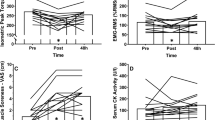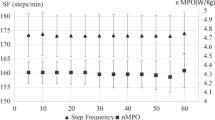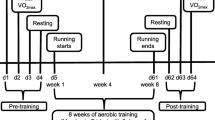Abstract
To determine the acute effects of a trail running competition and the age-dependent differences between young and master athletes, 23 subjects [10 young (30.5 ± 7 years), 13 master (45.9 ± 5.9 years)] participated in a 55-km trail running competition. The study was conceived as an intervention study compromising pre, post 1, 24, 48 and 72 h measurements. Measurements consisted of blood tests, ergometer cycling and maximal isometric voluntary contractions (MVC). Parameters monitored included MVC, twitch- and M-wave properties, EMG (RMS) of the vastus lateralis, two locomotion efficiency calculations and muscle damage markers in the blood (CK, LDH). Results indicate post-race increases in CK and LDH, decreases in MVC values (−32 vs. −40% in young and master, P < 0.01), decreases in EMG, increases in contraction time and concomitant decreases in peak twitch values, and a decrease in locomotion efficiency (−4.6 vs. −6.3% in young and master, P < 0.05). Masters showed similar fatigue and muscle damage than young but recuperation was slowed in masters. This study shows that trail runs are detrimental to muscle function, and gives indication that training may not halt muscle deterioration through aging, but can help maintain performance level.


Similar content being viewed by others
References
Baudry S, Klass M, Duchateau J (2005) Postactivation potentiation influences differently the nonlinear summation of contractions in young and elderly adults. J Appl Physiol 98:1243–1250
Bieuzen F, Hausswirth C, Louis J, Brisswalter J (2010) Age-related changes in neuromuscular function and performance following a high-intensity intermittent task in endurance-trained men. Gerontology 56:66–72
Braun WA, Dutto DJ (2003) The effects of a single bout of downhill running and ensuing delayed onset of muscle soreness on running economy performed 48 h later. Eur J Appl Physiol 90:29–34
Brisswalter J, Hausswirth C, Vercruyssen F, Collardeau M, Vallier JM, Lepers R, Goubault C (2000) Carbohydrate ingestion does not influence the charge in energy cost during a 2-h run in well-trained triathletes. Eur J Appl Physiol 81(1–2):108–113
Brouwer E (1957) One simple formulate for calculating the heat expenditure and the quantities of carbohydrate and fat oxidized in metabolism of men and animals from gaseous exchange (oxygen intake and caloric acid output) and urine-N. Acta Physiol Pharmacol Neerl 6:795–802
Clarkson PM, Nosaka K, Braun B (1992) Muscle function after exercise-induced muscle damage and rapid adaptation. Med Sci Sports Exerc 24:512–520
Coggan AR, Spina RJ, Rogers MA, King DS, Brown M, Nemeth PM, Holloszy JO (1990) Histochemical and enzymatic characteristics of skeletal muscle in master athletes. J Appl Physiol 68:1896–1901
Coyle EF, Sidossis LS, Horowitz JF, Beltz JD (1992) Cycling efficiency is related to the percentage of type 1 muscle fibers. Med Sci Sports Exerc 24(7):782–788
Fernström N, Bakkman L, Tonkonogi M, Shabalina IG, Rozhdestvenskaya Z, Mattsson CM, Enqvist JK, Ekblom B, Sahlin K (2007) Reduced efficiency, but increased fat oxidation, in mitochondria from human skeletal muscle after 24-h ultraendurance exercise. J Appl Physiol 102(5):1844–1849
Gaesser GA, Brooks GA (1975) Muscular efficiency during steady-rate exercise: effects of speed and work rate. J Appl Physiol 38(6):1137–1139
Gauché E, Lepers R, Rabita G, Leveque J-M, Bishop D, Brisswalter J, Hausswirth C (2006) Vitamin and mineral supplementation and neuromuscular recovery after a running race. Med Sci Sports Exerc 38(12):2110–2117
Gleeson M, Blannin AK, Walsh NP, Field CN, Pritchard JC (1998) Effect of exercise-induced muscle damage on the blood lactate response to incremental exercise in humans. Eur J Appl Physiol Occup Physiol 77:292–295
Henwood TR, Taaffe DR (2006) Short-term resistance training and the older adult: the effect of varied programmes for the enhancement of muscle strength and functional performance. Clin Physiol Funct Imaging 26:305–313
Hoffman MD, Wegelin JA (2009) The Western States 100-Mile Endurance Run: participation and performance trends. Med Sci Sports Exerc 41:2191–2198
Howley ET, Bassett DR, Welch HG (1995) Criteria for maximal oxygen uptake: review and commentary. Med Sci Sports Exerc 27:1292–1301
Lepers R (2009) Muscle fatigue following prolonged dynamic exercise. In: Shinohara M (ed) Advances in neuromuscular physiology of motor skills and muscle fatigue. Research Signpost, Trivandrum, pp 369–390
Lepers R, Pousson M, Maffiuletti N, Martin A, Van Hoecke J (2000a) The effects of a prolonged running exercise upon strength characteristics. Int J Sports Med 21:275–280
Lepers R, Hausswirth C, Maffiuletti N, Brisswalter J, Van Hoecke J (2000b) Evidence of neuromuscular fatigue after prolonged cycling exercise. Med Sci Sports Exerc 32(11):1880–1886
Lepers R, Sultana F, Bernard T, Hausswirth C, Brisswalter J (2010) Age related changes in triathlon performances. Int J Sport Med 31:251–256
Lexell J (1995) Human aging, muscle mass, and fiber type composition. J Gerontol A Biol Sci Med Sci 50:11–16
Louis J, Hausswirth C, Bieuzen F, Brisswalter J (2009) Muscle strength and metabolism in master athletes. Int J Sports Med 30(10):754–759
Martin DT, Quod MJ, Gore CJ, Coyle EF (2005) Has Armstrong's cycle efficiency improved? J Appl Physiol 99:1628–1629
Metzger JM, Moss RL (1990) Effects of tension and stiffness due to reduced pH in mammalian fast- and slow-twitch skinned skeletal muscle fibres. J Physiol 428:737–750
Miles MP, Walker EE, Conant SB, Hogan SP, Kidd JR (2006) Carbohydrate influences plasma interleukin-6 but not C-reactive protein or creatine kinase following a 32-km mountain trail race. Int J Sport Nutr Exerc Metab 16:36–46
Millet G, Lepers R, Lattier G, Martin V, Babault N, Maffiuletti N (2000) Influence of ultra-long term fatigue on the oxygen cost of two types of locomotion. Eur J Appl Physiol 83:376–380
Millet GY, Lepers R, Maffiuletti NA, Babault N, Martin V, Lattier G (2002) Alterations of neuromuscular function after an ultramarathon. J Appl Physiol 92:486–492
Millet GY, Martin V, Lattier G, Ballay Y (2003) Mechanisms contributing to knee extensor strength loss after prolonged running exercise. J Appl Physiol 94:193–198
Millet GY, Morin JB, Degache F, Edouard P, Feasson L, Verney J, Oullion R (2009) Running from Paris to Beijing: biomechanical and physiological consequences. Eur J Appl Physiol 107:731–738
Mogensen M, Bagger M, Pedersen PK, Fernstrom M, Sahlin K (2006) Cycling efficiency in humans is related to low UCP3 content and to type I fibres but not to mitochondrial efficiency. J Physiol 571:669–681
Moseley L, Jeukendrup AE (2001) The reliability of cycling efficiency. Med Sci Sports Exerc 33:621–627
Moysi JS, Garcia-Romero JC, Alvero-Cruz JR, Vicente-Rodriguez G, Ara I, Dorado C, Calbet JAL (2005) Effects of eccentric exercise on cycling efficiency. Can J Appl Physiol 30(3):259–275
Nicol C, Avela J, Komi PV (2006) The stretch-shortening cycle: a model to study naturally occurring neuromuscular fatigue. Sports Med 36:977–999
Nieman DC, Henson DA, McAnulty SR, McAnulty L, JD M, Ahmed A, Heward C (2004) Vitamin E and immunity after the Kona triathlon world championship. Med Sci Sports Exerc 36:1328–1335
Noakes TD (1987) Effect of exercise on serum enzyme activities in humans. Sports Med 4:245–267
Overgaard K, Fredsted A, Hyldal A, Ingemann-Hansen T, Gissel H, Clausen T (2004) Effects of running distance and training on Ca2+ content and damage in human muscle. Med Sci Sports Exerc 36:821–829
Place N, Lepers R, Deley G, Millet GY (2004) Time course of neuromuscular alterations during a prolonged running exercise. Med Sci Sports Exerc 36(8):1347–1356
Santalla A, Naranjo J, Terrados N (2009) Muscle efficiency improves over time in world-class cyclists. Med Sci Sports Exerc 41:1096–1101
Sharwood KA, Collins M, Goedecke JH, Wilson G, Noakes TD (2004) Weight changes, medical complications, and performance during an Ironman triathlon. Br J Sports Med 38:718–724
Shima N, McNeil CJ, Rice CL (2007) Mechanomyographic and electromyographic responses to stimulated and voluntary contractions in the dorsiflexors of young and old men. Muscle Nerve 35:371–378
Stearns RL, Casa DJ, Lopez RM, McDermott BP, Gunio MS, Decher NR, Seruggs IC, West AE, Armstrong LE, Maresh CM (2009) Influence of hydration status on pacing during trail running in the heat. J Strength Cond Res 23:2533–2541
Sultana F, Brisswalter J, Lepers R, Hausswirth C, Bernard T (2008) Effects of age and gender on Olympic triathlon performances. Sci Sports 23:130–135
Suzuki K, Peake J, Nosaka K, Okutsu M, Abbiss CR, Surriano R, Bishop D, Quod MJ, Lee H, Martin DT, Laursen PB (2006) Changes in markers of muscle damage, inflammation and HSP70 after an Ironman triathlon race. Eur J Appl Physiol 98:525–534
Tanaka H, Seals DR (2008) Endurance exercise performance in masters athletes: age-associated changes and underlying physiological mechanisms. J Physiol 586(1):56–63
Tarpenning KM, Hamilton-Wessler M, Wiswell RA, Hawkins SA (2004) Endurance training delays age of decline in leg strength and muscle morphology. Med Sci Sports Exerc 36:74–78
Thompson LV (2009) Age-related muscle dysfunction. Exp Gerontol 44:106–111
Warren GL, Lowe DA, Armstrong RB (1999) Measurement tools used in the study of eccentric contraction-induced injury. Sports Med 27(1):43–59
Wasserman K, Whipp BJ, Koyl SN, Beaver WL (1973) Anaerobic threshold and respiratory gas exchange during exercise. J Appl Physiol 35:236–243
Westerblad H, Lee JA, Lannergren J, Allen DG (1991) Cellular mechanisms of fatigue in skeletal muscle. Am J Physiol 261:C195–C209
Author information
Authors and Affiliations
Corresponding author
Additional information
Communicated by Toshio Moritani.
Rights and permissions
About this article
Cite this article
Easthope, C.S., Hausswirth, C., Louis, J. et al. Effects of a trail running competition on muscular performance and efficiency in well-trained young and master athletes. Eur J Appl Physiol 110, 1107–1116 (2010). https://doi.org/10.1007/s00421-010-1597-1
Accepted:
Published:
Issue Date:
DOI: https://doi.org/10.1007/s00421-010-1597-1




